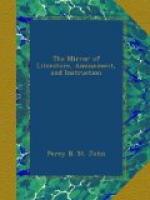During his lifetime, Shakspeare acquired reputation principally through his poems, which from some unaccountable cause, are now comparatively neglected, and we may add unfortunately so for the enjoyment of the public. These poems were more admired than his plays, and what speaks higher in their favour, they are more expressively alluded to by contemporary writers. The “Venus and Adonis” is a splendid piece of composition, and very touching in its sentiment; even its illustrious author was proud to call it “the first heir of his invention.” We have from it one of our most popular songs, which constitutes one of its stanzas:
“Bid me discourse, I will enchant
thine ear,
Or like a fairy, trip upon
the green,
Or like a nymph with long dishevell’d
hair
Dance on the sands, and yet
no footing seen.”
His ready talent for composition was singular, and perhaps unparalleled; his mind and hand ever went together, and it is reported he was never known to blot a line. He was an actor occasionally in his own plays, but it does not indeed appear that he excelled in this art.
Shakspeare never considered his works worthy of posterity, and was little careful of popularity while he lived; having acquired a competency by his labours, he retired to Stratford, and spent the remainder of his life in ease and retirement, like a private gentleman. His income was estimated at L200. The epitaph—not that on his monument, but on the rude stone actually covering his remains is to the following effect, and thus curiously written:
“Good friend, for Jesus SAKE
forbeare
To digg T—E dust EncloAsed HERE
T
Blese be T—E man spares TEs stones
T y
And curst be hey moves my bones.”
I conclude this rather desultory article with Lord Lyttleton’s splendid eulogy on him, which in a few words expresses more than the finest Philippic to his memory—“If all human things were to perish except the works of Shakspeare, it might still be known from them what sort of a creature Man was!”
F.
* * * * *
SIR THOMAS FOWLER’S LODGE, ISLINGTON.
[Illustration: SIR THOMAS FOWLER’S LODGE, ISLINGTON.]
Few parishes in the environs of London are so rich in architectural antiquities as the “considerable village” of Islington. Canonbury-house, of which a solitary tower remains, is said to have been the country-residence of the Priors of St. Bartholomew, and to have been rebuilt early in the 16th century. Highbury belonged also to the Priory. The existing relics are chiefly of the Elizabethan age. The lodge, represented in the cut, belonged to an old mansion; the property of the Fowler family, built in 1595, which appears on a ceiling. The house fronts Cross-street, and the lodge is at the extremity of the garden, and adjoins Canonbury Fields. It is most probable that this was built as a summer-house by Sir Thomas Fowler, the younger, whose arms are placed in the wall, with the date 1655. It has been absurdly called Queen Elizabeth’s Lodge, but with no other foundation than her majesty having passed through it when on a visit to Sir Thomas Fowler.




